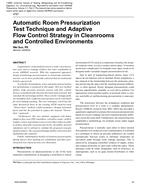Description
A quantitative relationship between a room’s pressurization ratio and its leakage airflows has been established in recent ASHRAE research. With this engineered approach, design of multistage pressurizations in cleanrooms and laboratories can be more predictably achieved than by traditional intuitive guesswork.
As a further development, a new automatic pressurization test methodology is proposed in this paper. This new method utilizes room precision pressure sensors and flow control devices to automatically measure the room static pressure and calculate the net leakage airflow. Once a room’s leakage paths are identified, flow coefficient and exponent can be calculated for each leakage opening. This new technique, which has the same theoretical basis as the existing ASTM room-by-room “blower door†method, is fully automatic, cheaper, and much faster and has the potential to replace the manual “blowerdoor†approach.
Furthermore, this new method, equipped with future adaptive flow reset PID controllers, will allow rooms’ airflow (supply, return, and exhaust) rates to reset their values in order to achieve desirable room pressure levels. An airflow network simulation tool is utilized to validate the proposed concepts and procedures. The concept of leakage airflow network is also mathematically explored.
Finally, mathematical models of transient pressurization during barrier door opening are established, and their pressurization loss characteristics are illustrated.
Citation: ASHRAE Trans. vol. 111, pt. 2, paper no. 4787, p. 23-34, Denver 2005
Product Details
- Published:
- 2005
- File Size:
- 1 file , 4 MB
- Product Code(s):
- D-26987




